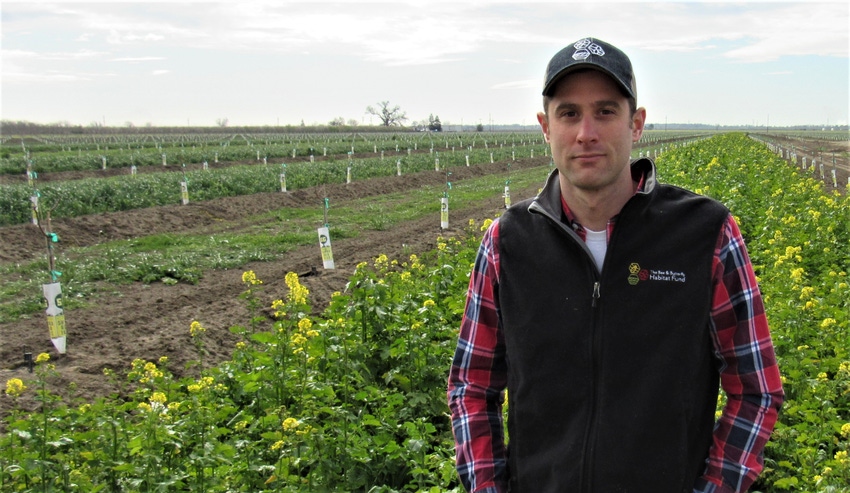
While some tree nut growers have adopted cover crops into their orchard plans, most are slow to embrace new strategies when their current method of operation has proven successful.
According to the University of California’s Cooperative Extension’s Agricultural Issues Center, nearly 1.5 million acres of tree nuts are planted in the state, but just over 8,000 of those acres are planted with cover crops as an integral part of orchard operations.
Despite the slow uptick in the use of cover crops in tree nut orchards, interest still runs moderately high in an industry known to embrace new ideas to improve productivity and profit, and to better protect the environment.
While the reason behind the slow response to embrace cover crops in tree nut orchards are varied and many, researchers are uncovering new data that points to the advantages.
“Cover crop popularity and use is growing in California. They are being promoted by USDAs Natural Resources Conservation Service (NRCS), non-profits like Community Alliance for Family Farmers and others, and there is more awareness of their benefits now than ever before,” reports Billy Synk, Director of Pollination Services with Project Apis m., a nonprofit whose primary mission is to enhance the health and vitality of honey bee colonies.
Growing cover crops in an orchard offers many benefits, he said, including the reduction of soil erosion and compaction, water infiltration, and improving overall soil fertility.
Growing interest
With a colder than average winter and record rainstorms before and during bloom this year in many areas, there may be growing interest in cover crops to address some of the problems currently being experienced - issues like standing water and erosion. But the latest and emerging benefit being offered by supporters of cover crop use in the orchard may be that cover crops can attract native honey bees long before contract pollinators arrive and improve bee performance once out-of-state bees are placed in the orchard.
“Honey bees spend much of the dormant season, over the winter, huddling together to keep the queen and other bees warm and they don’t have a lot to do. In order to trigger those bees in the spring season they need things like longer days and more light, warmer temperatures and most importantly pollen to return to their normal cycle of activity,” Synk said.
Project Apis m. funds research and special projects, one of them being a cover crop seed bank that provides seeds to California growers.
“Bee colonies that are trucked into the orchard each spring are in need of nutrition and cover crops can provide early pollination resources that improves bee activity once tree nut bloom arrives,” he said.
Synk says Almond tree blooms offer a more nutritious diet for bees that quickly turn their attention away from cover crops and opt for the higher quality pollen of the tree nuts.
“Early bee activity and pollination in cover crops helps the colony to be healthier and enhances colony populations to grow faster as well, making bees perform better all throughout the orchard.”
Keeping bees nearby
He says cover crops may also help in keeping bees interested in your orchard rather than spreading out to other orchards in search of pollen.
“Contractors bring nearly two million bee colonies into the state beginning as early as January when there is little or no available pollen sources. The bees have not foraged for an extended period and are at the weakest upon arriving. Providing an early source for pollen in the orchard can prove to increase bee productivity once tree bloom arrives.”
When foraging bees bring back the first pollen of the new year and return to the colony, the Queen begins to lay more eggs and the hive begins to rear larvae. These larvae emit a pheromone which stimulates more foraging bees to seek out flower blooms to pollinate. Synk says this positive feedback loop will continue if resources are available.
According to the Project Apis m. website, choosing the right cover crop varieties can have a significant impact on soil as well. Cover crops penetrate hard ground with their roots and hold the soil together by creating stronger aggregates, which also increases water infiltration and prevents erosion. Nitrogen-fixing legumes like clover and vetch can add significant nitrogen to the soil as well.
Synk says a careful selection of cover crop seeds should be used, often a mix of clovers and mustard plants. Cover can be planted in rows or in hedge rows surrounding an orchard. For non-perennial cover crops, they are generally planted in the fall. They are then removed each year usually before March 1, though clover is usually allowed to stay in the orchard an additional 60 days or more.
“Another advantage is that when eggs hatch into larvae, it signals the colony to venture out and forage more for pollen, ultimately helping to increase population numbers and the general health of the hive. In this way cover crops serve to provide early pollen for bees to become more active and to thrive,” says Synk
Bees ‘sit around and wait’
“A lot of the time bees that are trucked into orchards arrive as early as January and they must sit around and wait for tree nut bloom to begin gathering pollen, or they venture out and spread to nearby properties in search of pollen sources. By providing cover crops that make pollen available earlier in the season, bees tend to stay near the hive and this further benefits growers and their investment in bringing bees in,” Synk noted.
Concerning water issues, he said the most popular seed mixes have low moisture requirements and orchard operators will make the decision whether to plant a new winter season of cover crops after determining soil moisture levels and whether there is adequate water to plant them. Some orchards rotate on and off-years for cover crops depending on moisture availability.
“Tree nut growers are businessmen, and while they are concerned about bee health and safety, they are most concerned about growing almonds. Making a decision to include cover crops as part of their operating strategy is probably something they are not ready to jump into until they can digest the many benefits involved.”
To help growers warm up to the idea, Project Apis m. offers annual enrollment into a cover crop program with an application deadline of July 1.
“The first year a grower decides to try cover crops, Project Apis m. offers $2,000 worth of free seeds as an incentive to ‘test drive’ a cover crop program. The second year they receive $1,000 of free seeds. Free shipping and consultation are always provided for growers.”
Synk reminds growers that Project Apis m. is a non-profit organization and that is reflected in seed costs. He warns that cover crops are not a magic bullet. Depending on environmental conditions and availability of water, not every benefit will necessarily be realized the same way every year. That is one of the primary purposes of offering free seeds to help growers get started so they can better evaluate the benefits of cover crops in tree nut operations.
For more information or to contact Synk, visit the Project Apis m. website.
About the Author(s)
You May Also Like






